Today, Leica has announced the Leica M10-D. Based on the recently introduced M10-P digital rangefinder, the M10-D takes the analog aesthetic to a whole new level. With no rear LCD display, an ultra quiet shutter, and a clever fold-out thumb rest that looks like a manual film advance lever, the camera could easily be mistaken for a film M. Sporting a matte black anodized finish, white classic Leica engraved script on top, no red dot on the front and genuine black leather covering, the M10-D looks subtle and classic.
The lack of a rear display on a digital M was first seen in the limited Leica M Edition 60, which commemorated 60 years of M photography in 2014. Due to popular demand, Leica rolled out the purist concept in a regular production model, the M-D (Typ 262), less than two years later. And while the M-D 262 had the right idea, functionality was limited, with no way to adjust settings. Some users also felt that the M240-based body was still too thick to be a pure M. The M10-D addresses all the concerns of the M262 and puts forth the most analog-feeling digital camera ever made.
Based on the M10-P, the M10-D gets some notable upgrades over the previous M-D. The body is thinner, with the same overall dimensions as a film M7. A physical ISO dial looks like a classic rewind knob.The shutter is almost too quiet. Under the hood, the exceptional 24 megapixel CMOS sensor and Maestro II processor tackle just about every lighting scenario and offer up to 5 fps shooting speed.
Replacing the rear LCD display, a central dial control provides direct access to exposure compensation and also functions as an On/Off/WiFi switch. On the top of the camera is the ISO dial, shutter speed dial, shutter release and….advance lever? Unfortunately, for all those hoping for a manual advance option, the lever is merely a cleverly-styled, retractable thumb rest. Still, the functionality of a traditional advance lever as a thumb rest will be a welcome addition for many users who might miss the feel of their M film cameras. And it really adds to the overall iconic look of the M10-D.
Even though the M10-D does away with the LCD screen, the camera does support the use of the Visoflex 020 EVF for those wanting the analog feel, but the convenience of live view. Best of both worlds. To maintain full LV functionality, the front focus aid button and rear thumb dial remain. But, the EVF's role is limited to image capture with no support for playback or menu operation. There's also a button on the top deck, to the right of the shutter release, which toggles display for battery and shots remaining in the optical finder.
Unlike the previous M-D, the M10-D's menus can be accessed over WiFi using the newly introduced Leica FOTOS app. Additionally, you can review and even download images from the M10-D using the app, which is available for both iOS and Android.
The Leica M10-D is a camera for, shall we say, pragmatic purists. All the aesthetics and feel of an analog Leica M, with the flexibility, discreteness and image quality of an M10-P.
Pricing and Availability
The Leica M10-D is now available for pre-order at Leica Store Miami for $7,995. You can place a pre-order by clicking the link below, emailing info@leicastoremiami.com, or calling 305-921-4433.
Press Release
Leica Camera is pleased to announce the latest addition to the Leica M family, the Leica M10-D. The new Leica M10-D continues the philosophy that began with the Leica M-D (Typ 262) of using a digital camera with no rear display. The concept is based around the idea of using a camera completely free from distractions, allowing the user to fully focus on their subjects and the core photographic settings at hand.
With no menu or playback on the camera, users can simply focus on the moment and enjoy a classic style rangefinder that operates and looks just like an analog camera. With no “chimping,” the photographer can be focused on the next shot while they anticipate enjoying their photos later, either back at home when downloading the SD card or when connecting to WiFi on the go.
Based on the Leica M10-P, the Leica M10-D has a redesigned On/Off switch with an integrated hard Wi-Fi On setting. The new Leica FOTOS app is a key aspect of the M10-D, allowing for access to the photos on the SD card, while also controlling camera settings such as date/time, JPG/DNG controls, SD card formatting, and more options that are usually needed only once in a while. By combining the analog experience of shooting a digital camera without a display and the mobile connectivity of WiFi, the M10-D becomes the perfect hybrid between analog and connected worlds. The photographer has the freedom to choose how they embrace it and fit it into their life.
- No LCD for an analog experience
- Hard switch for quick access to Wi-Fi
- Built-in Exposure Compensation dial on rear
- Integrated fold-out thumb rest
- Compatible with Visoflex EVF for Live View capture
- Works perfectly with Leica FOTOS app
- Same design/specs as M10-P
- Quiet shutter
- Body covering made from genuine leather
The new selector switch for Off / On / On with WiFi is reminiscent of classic ISO dials from Leica analog M cameras, and allows for the addition of a dedicated Exposure Compensation wheel – a first for digital M cameras.
The integrated fold-out thumb rest completes the film camera aesthetic and gives improved handling, especially with heavier lenses. Its function is purely ergonomic. The button to the right of the shutter release allows for checking SD card storage (remaining shots) and battery level in the built-in viewfinder.
The optional Leica Visoflex EVF allows the use of Live View capture for pin-point accurate focusing/ framing and compatibility with super wide-angle lenses. The EVF can only be used for viewing and capture, as the Menu and Play functions cannot be used with it.
The new Leica FOTOS app augments the M10-D much further than any previous Leica camera with no LCD. Now the user can access, download, and share their photos on the go as well as use remote shooting to take pictures via Live View with their smartphone as the viewfinder. Now the first time you see your photos is on the high quality display that is in your pocket, and they are ready to share.
Tech Specs
| Camera type: | Leica M10-D, compact digital rangefinder system camera | |
| Lens mount: | Leica M bayonet with additional sensor for 6-bit coding | |
| Lens system: | Leica M lenses, R lenses can be used with optional adapter | |
| Image Sensor: | CMOS chip, active surface 24x36mm | |
| Resolution: | DNG: 5976×3992 pixels (24MP), JPEG: 5952×3968 pixels (24MP) | |
| Data Format: | DNG (raw data, lossless compression), JPEG | |
| File Size: | DNG: 20-30 MB, JPEG depending on resolution and picture content | |
| Buffer Memory: | 2GB / 16 pictures in series | |
| White Balance: | Automatic, manual, 8 presets, color temperature input | |
| Storage Medium: | SD cards up to 2GB, SDHC cards up to 32GB, SDXC cards up to 2TB | |
| Menu Language: | German, English, French, Spanish, Italian, Portuguese, Japanese, Traditional Chinese, Simplified Chinese, Russian, Korean | |
| Exposure Metering: | Exposure metering through the lens (TTL), with working aperture | |
| Metering Method: | For metering the light reflected by light blades of the 1st shutter curtain onto a measuring cell: Strong center-weighted; for metering on the sensor: Spot, center-weighted, multi-field metering | |
| Metering Range: | At room temperature and normal humidity for ISO 100, at aperture 1.0 EV-1 to EV20 at aperture 32. Flashing of the left triangular LED in the viewfinder indicates values below the metering range | |
| Sensitivity Range: | ISO 100 to ISO 50000, adjustable in 1/3 ISO increments from ISO 200, choice of automatic control or manual setting | |
| Exposure Modes: | Choice of automatic shutter speed control with manual aperture pre-selection – aperture priority A, or manual shutter speed and aperture setting | |
| Flash Exposure Control | ||
| Flash Unit Attachment: | Via accessory shoe with central and control contacts | |
| Synchronization: | Optionally triggered at the 1st or 2nd Shutter curtain | |
| Flash Sync Time: | 1/180s; slower shutter speeds can be used, if working below sync speed: Automatic changeover to TTL linear flash mode with HSS compatible Leica system flash units | |
| Flash Exposure Metering: | Using center-weighted TTL pre-flash metering with Leica flash units (SF40, SF64, SF26, SF60), or flash units compatible with the system with SCA3502 M5 adapter | |
| Flash Measurement Cell: | 2 silicon photo diodes with collection lens on the camera base | |
| Flash Exposure Compensation: | ±3EV in1⁄3 EV increments | |
| Displays in Flash Mode (in viewfinder only): | Using flash symbol LED | |
| Viewfinder | ||
| Construction Principle: | Large, bright line frame viewfinder with automatic parallax compensation | |
| Eyepiece: | Calibrated to -0.5 diopter; corrective lenses from -3 to +3 diopter available | |
| Image Field Limiter: | By activating two bright lines each: For 35 and 135mm, for 28 and 90mm, or for 50 and 75mm; automatic switching when lens is attached | |
| Parallax Compensation: | The horizontal and vertical difference between the viewfinder and the lens is automatically compensated according to the relevant distance setting, i.e. the viewfinder bright-line automatically aligns with the subject detail recorded by the lens. | |
| Matching Viewfinder & Actual Image: | At a range setting of 2m, the bright-line frame size corresponds exactly to the sensor size of approx. 23.9 x 35.8mm; at infinity setting, depending on the focal length, approx. 7.3% (28mm) to 18% (135mm) more is recorded by the sensor than indicated by the corresponding bright line frame and slightly less for shorter distance settings than 2m | |
| Magnification (For all lenses): | 0.73x | |
| Large-base Range Finder: | Split or superimposed image range finder shown as a bright field in the center of the viewfinder image | |
| Effective Metering Basis: | 50.6mm (mechanical measurement basis 69.31mm x viewfinder magnification 0.73x) | |
| Displays | ||
| In the Viewfinder: | Four-digit digital display with dots above and below | |
| On Back: | No LCD screen. Rear of camera has two dials, one for on/off and WiFi and another for exposure compensation | |
| Shutter & Shutter Release | ||
| Shutter: | Metal blade focal plane shutter with vertical movement, near-silent operation | |
| Shutter Speeds: | For aperture priority: (A) continuous from 125s to 1/4000s. For manual adjustment: 8s to 1⁄4000s in half steps, from 8s to 125s in whole steps, B: For long exposures up to maximum 125s (in conjunction with self-timer T function, i.e. 1st release = shutter opens, 2nd release = shutter closes),(1⁄180s): Fastest shutter speed for flash synchronization, HSS linear flash mode possible with all shutter speeds faster than 1⁄180s (with HSS-compatible Leica system flash units) | |
| Picture Series: | approx. 5 pictures per second, 30-40 pictures in series | |
| Shutter Release Button: | Two-stage, 1st step: Activation of the camera electronics including exposure metering and exposure lock (in aperture priority mode), 2nd step: Shutter release; standard thread for cable release integrated. | |
| Self-Timer: | Delay 2s (aperture priority and manual exposure setting) or 12s, set in menu, indicated by flashing LED on front of camera and corresponding display in monitor. | |
| Turning The Camera On/Off: | Using main switch on back of camera; optional automatic shutdown of camera electronics after approx. 2/5/10 minutes; reactivated by tapping the shutter release | |
| Power Supply: | 1 lithium ion rechargeable battery, nominal voltage 7.4V, capacity 1300mAh.; maximum charging current/voltage: DC 1000mA, 7.4V; Model No.: BP-SCL5; Manufacturer: PT. VARTA Microbattery, Made in Indonesia, Operating conditions (in camera): 0°C – + 40°C | |
| Charger: | Inputs: 100-240V AC, 50/60Hz, 300mA, automatic switching, or 12V DC, 1.3A; Output: DC 7.4V, 1000mA/max. 8.25V, 1100mA; Model No.: BC-SCL5; Manufacturer: Guangdong PISEN Electronics Co., Ltd., Made in China, Operating conditions: 0°C – + 35°C | |
| GPS: | Only with Leica Visoflex viewfinder attached, available as an accessory | |
| Wi-Fi: | Complies with IEEE 802.11b/g/n standard (standard WiFi protocol), channel 1-11, encryption method: WiFi-compatible WPA/WPA2 encryption, access method: Infrastructure mode | |
| Camera Body | ||
| Material: | All-metal die cast magnesium body, leather covering. Brass top panel and base. | |
| Image Field Selector: | Allows the bright-line pairs to be manually activated at any time (e.g. to compare detail) | |
| Tripod Thread: | A ¼” DIN stainless steel in bottom | |
| Operating Conditions: | 0-40°C | |
| Interfaces: | ISO accessory shoe with additional contacts for Leica Visoflex viewfinder (available as an accessory) | |
| Dimensions: | (width x depth x height): approx. 139 x 38.5 x 80mm | |
| Weight: | approx. 680g (with battery) | |
| Scope of Delivery: | Charger 100-240V with 2 mains cables (Euro, USA,) and 1 car charging cable, lithium ion battery, carrying strap, body bayonet cover, cover for accessory shoe |

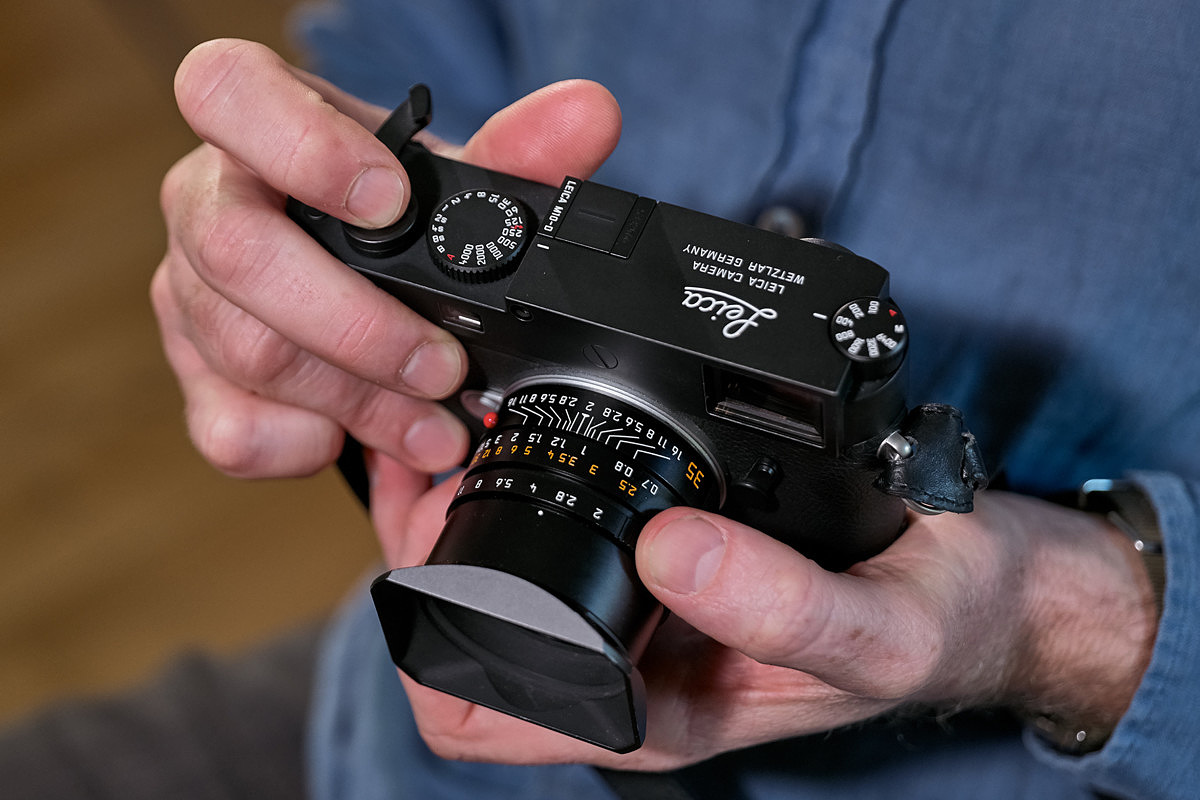
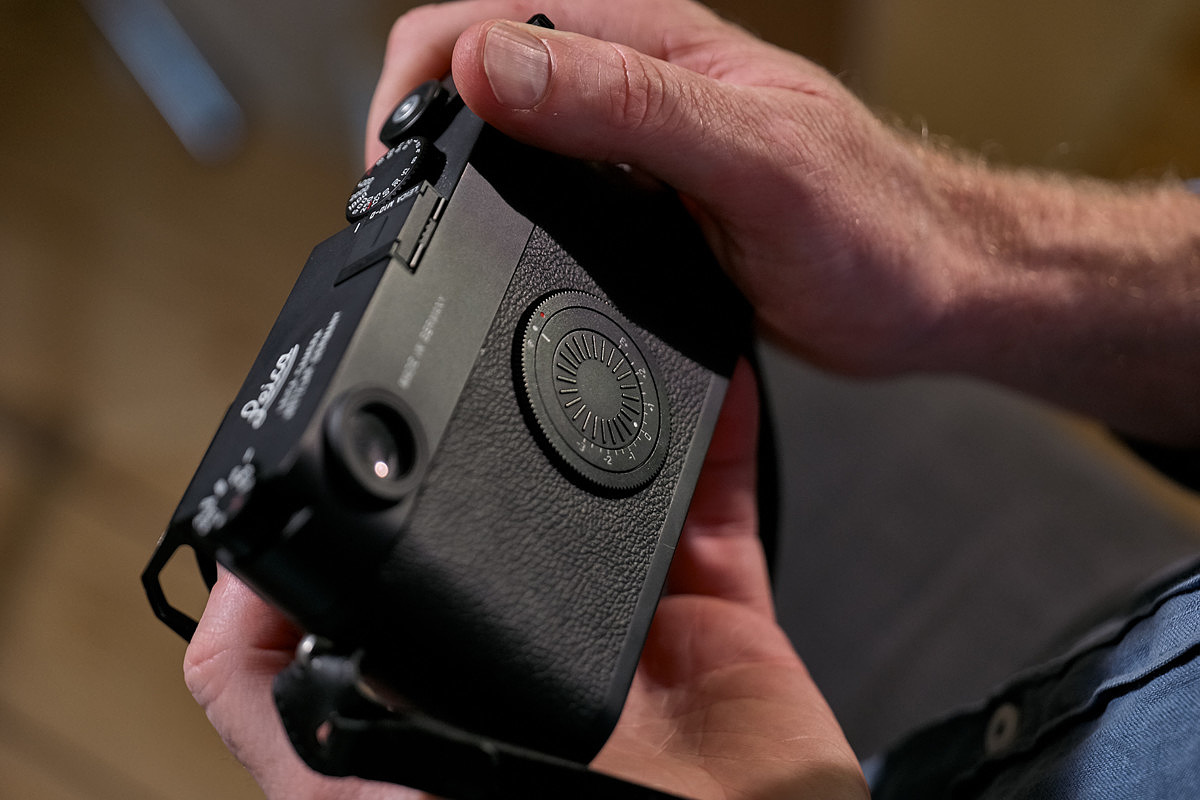
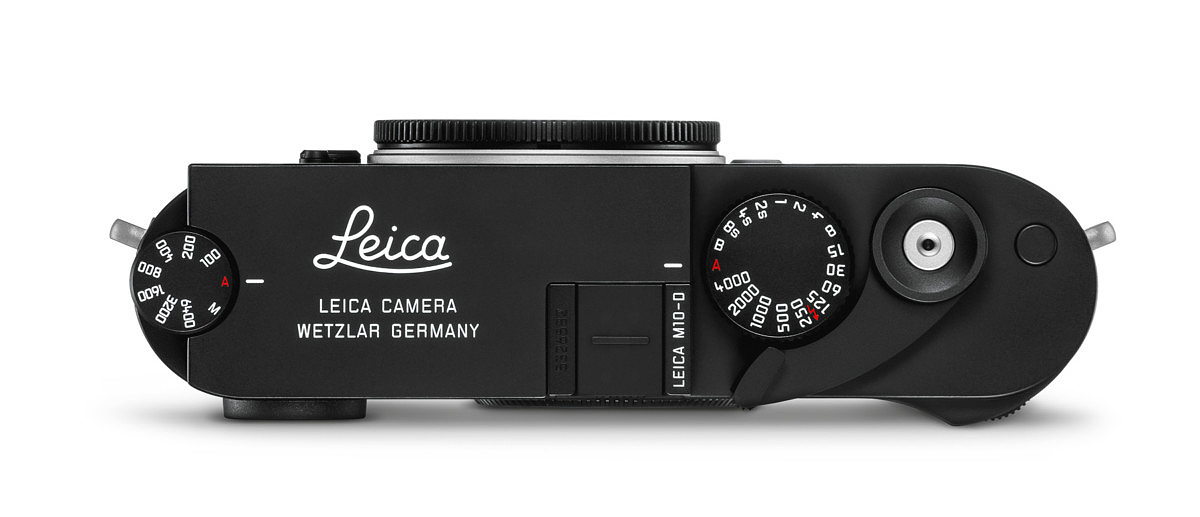
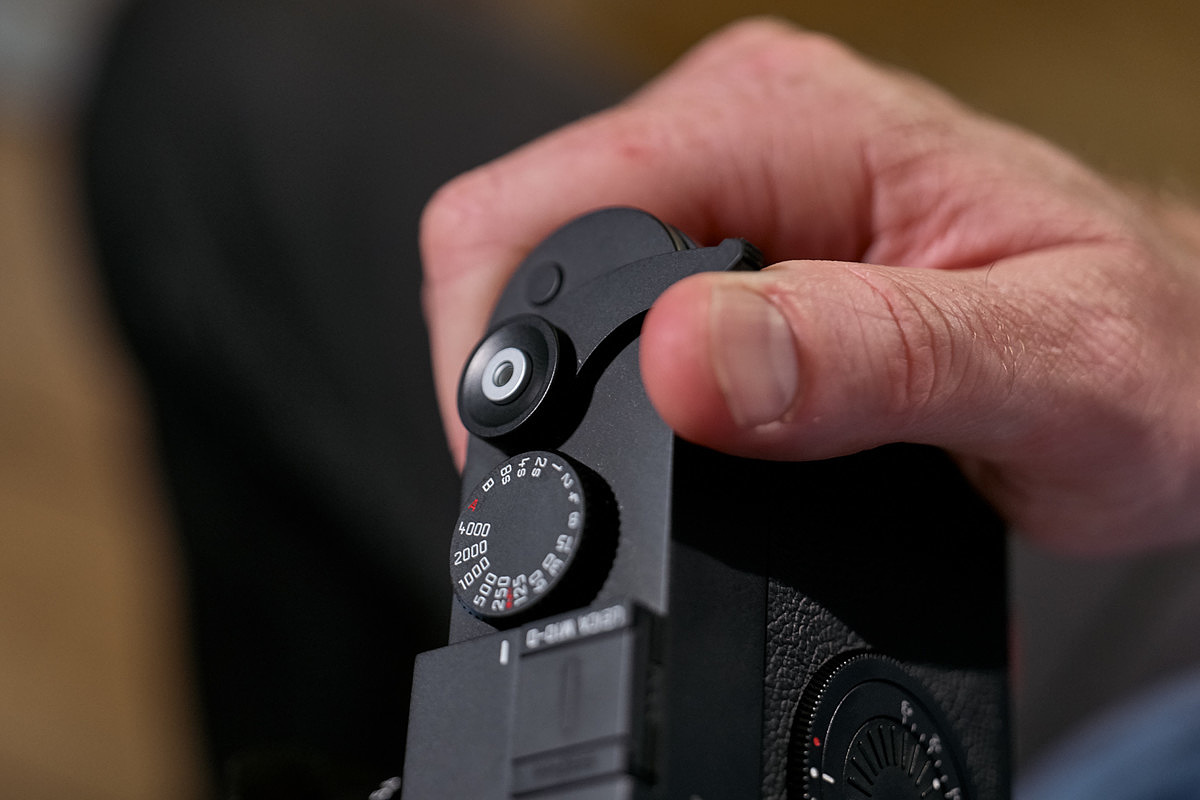
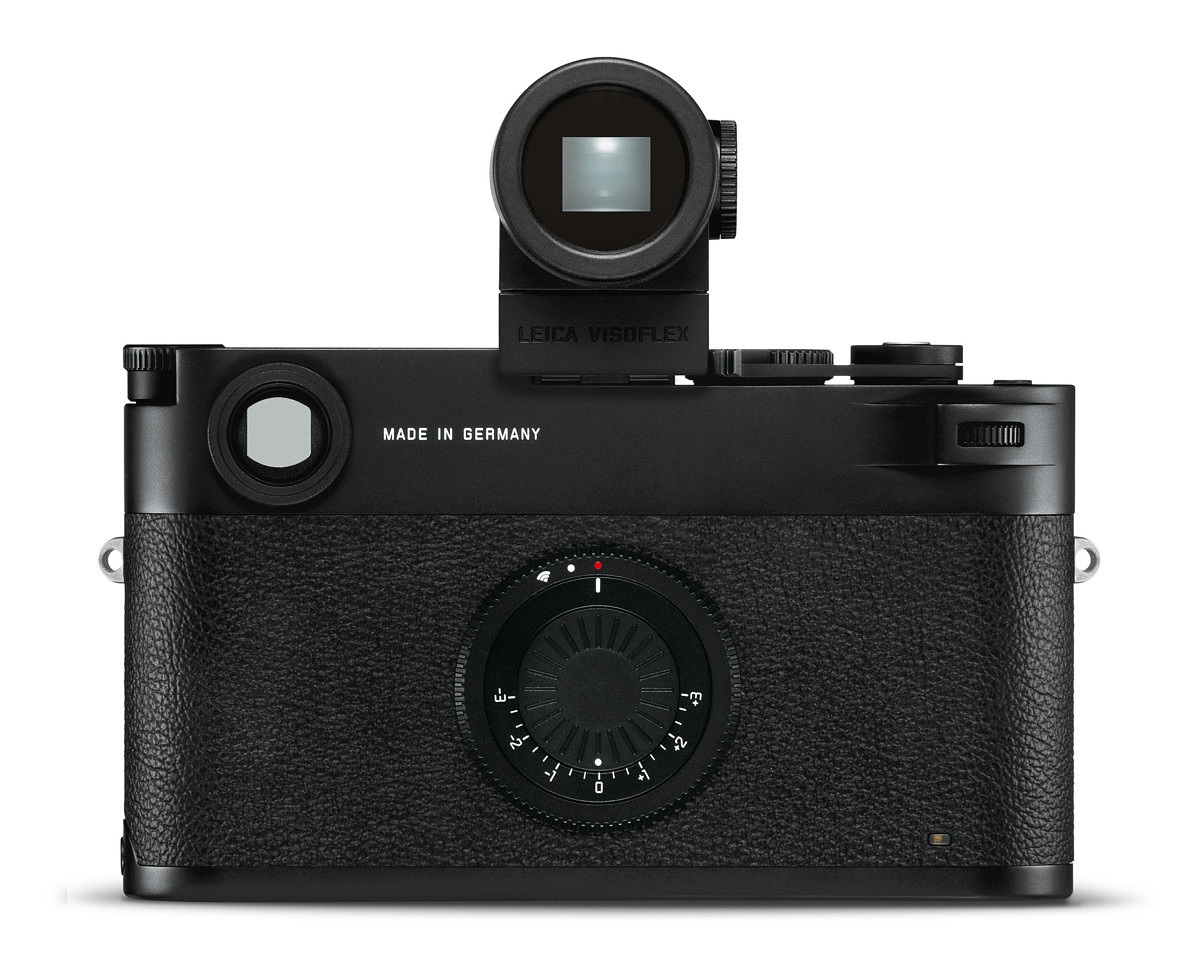
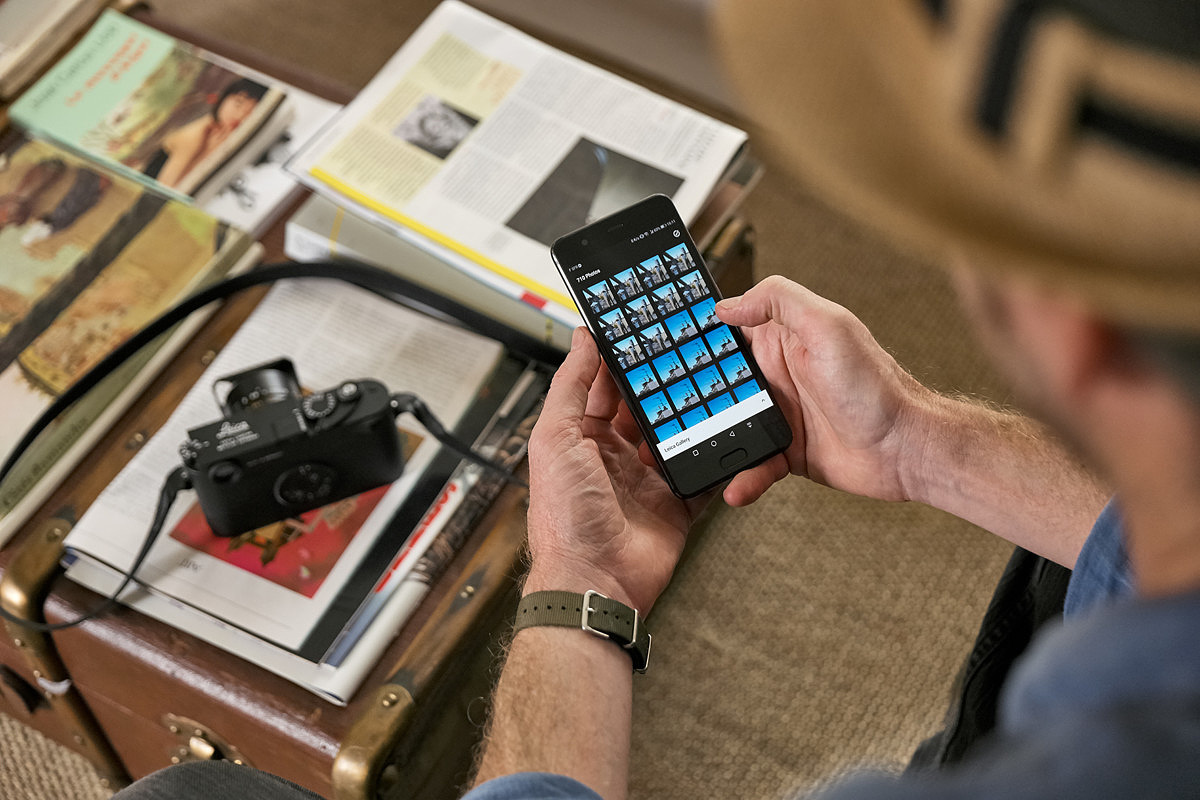
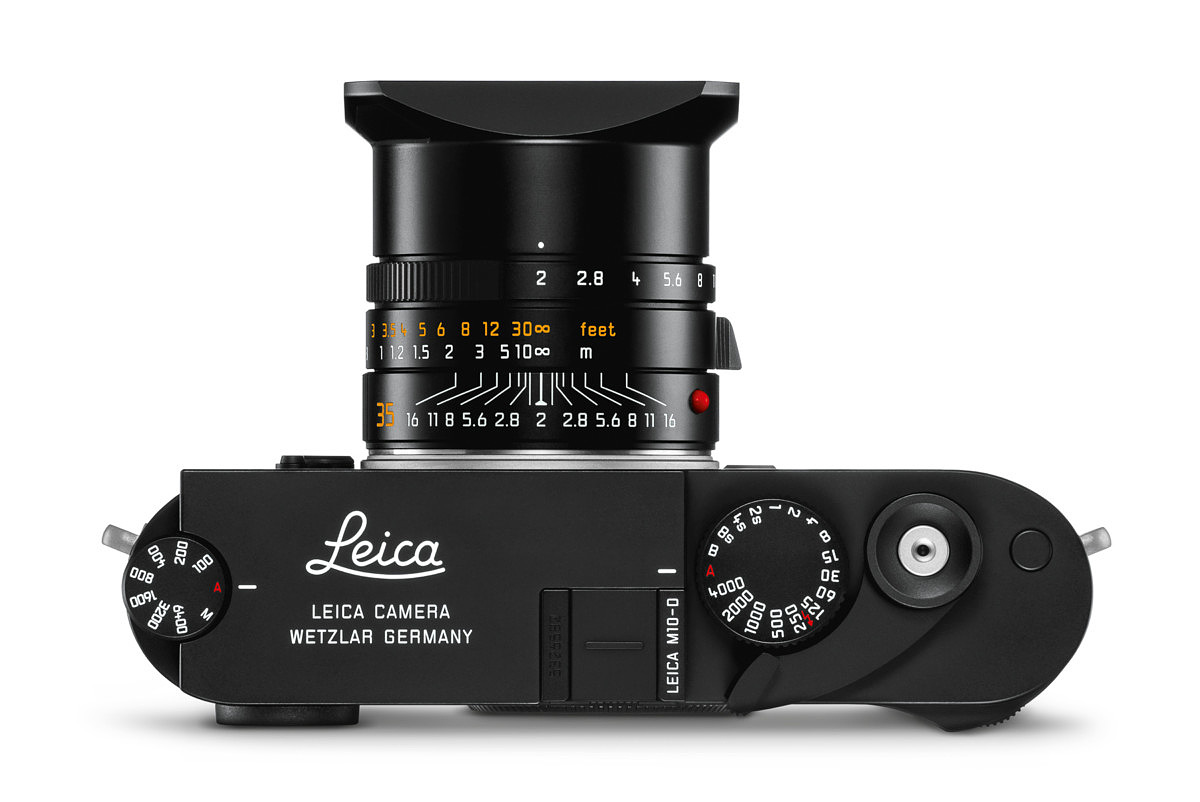
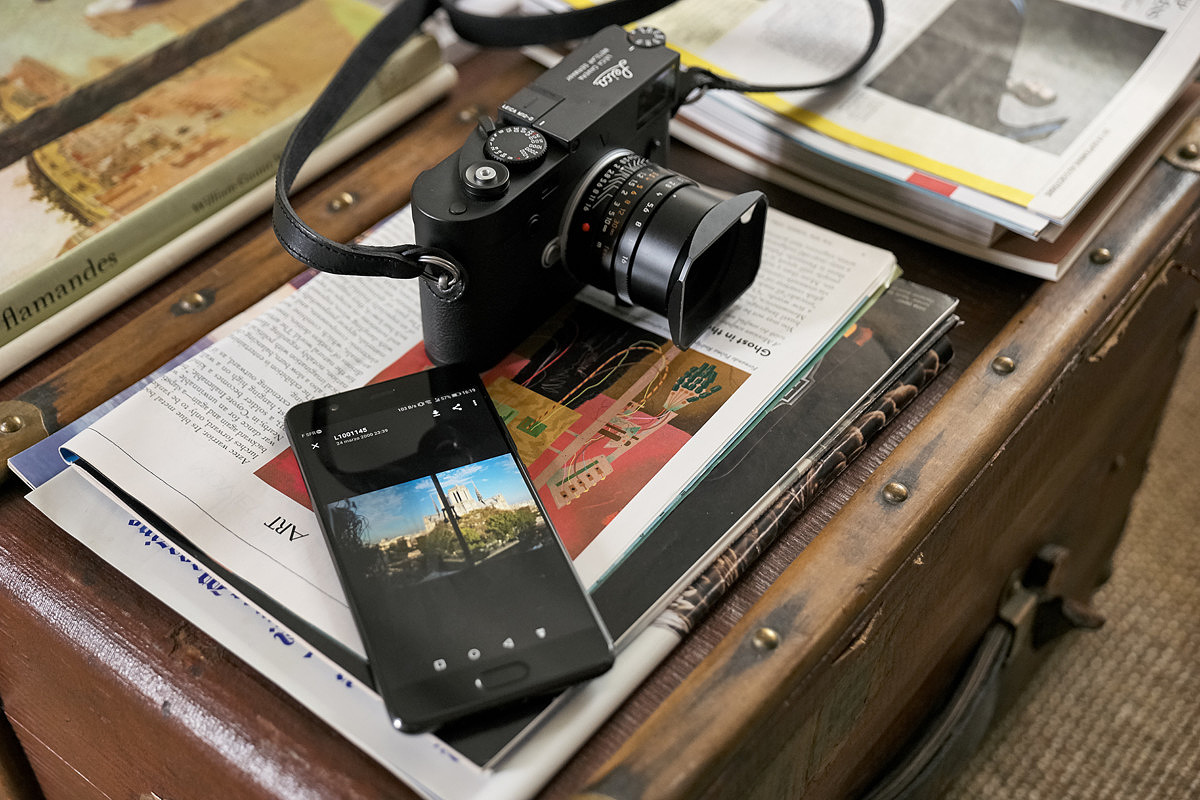
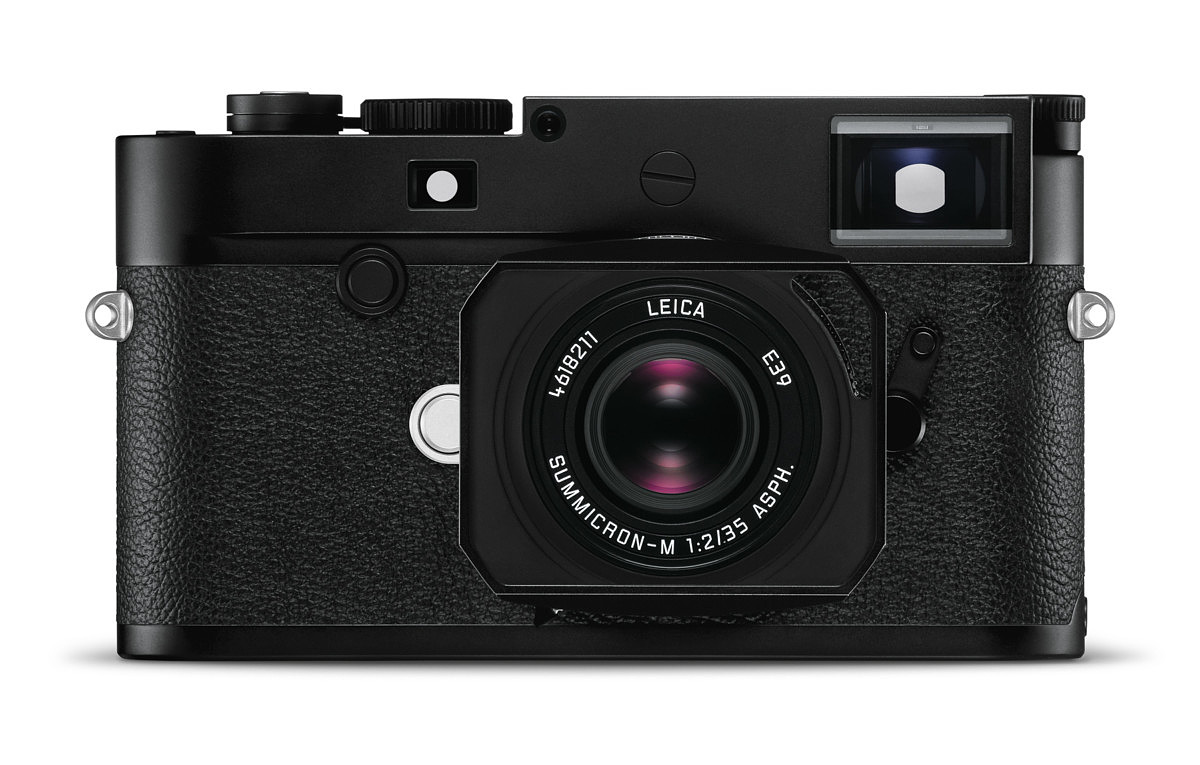
I know that I beat a dead horse, but why black anodized only ? This time even the silver is gone…
I read your interview with Jesko von Oeynhausen, and one question was:
“Why not black paint?”
Answer:
“Wow, you are maybe the fourth person to ask me this today![…]”
Yes Mr. Oeynhausen, *maybe* there is some *slight* interest in a black paint body, what do you say? 🙂
As for the rest, a nice body in my opinion, a little less extreme than the predecessor.
The faux film rewind lever, however, it is something I’d expect to see in a Voigtländer body, not a proper Leica M…